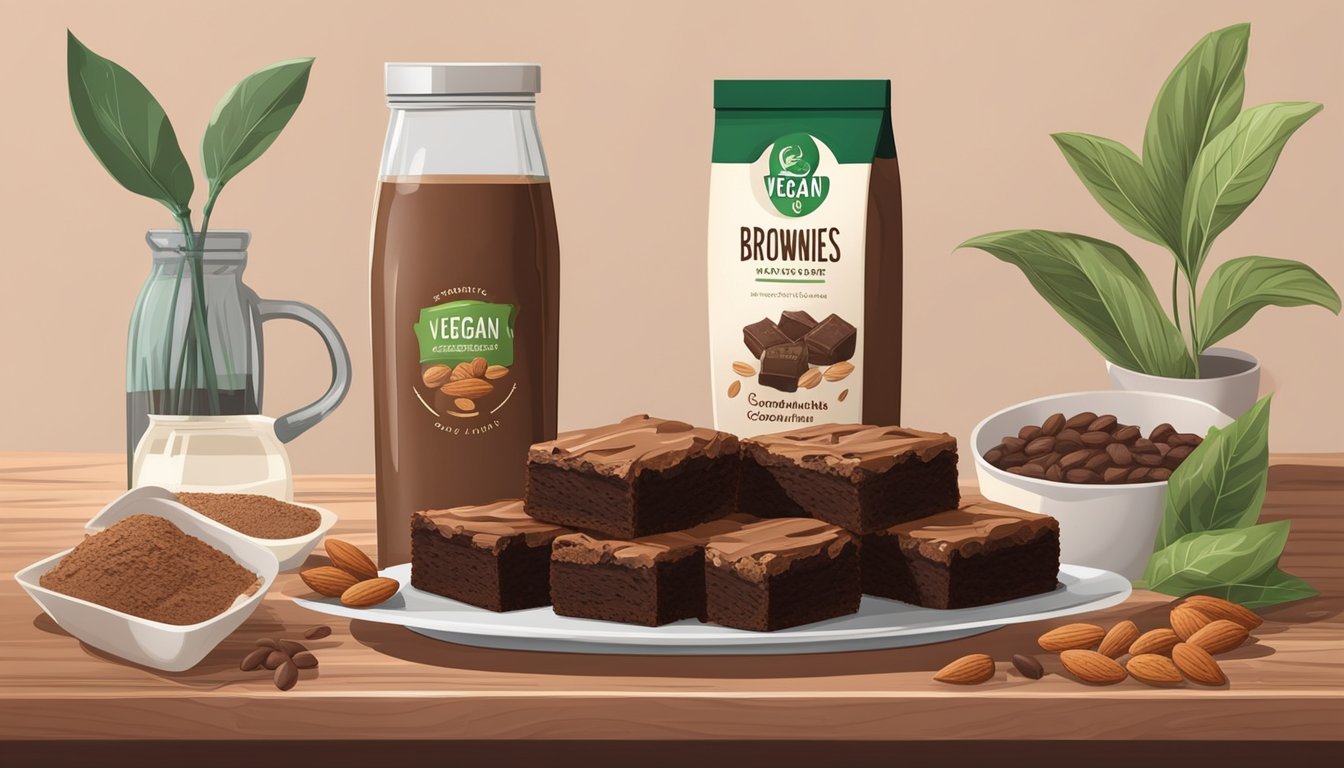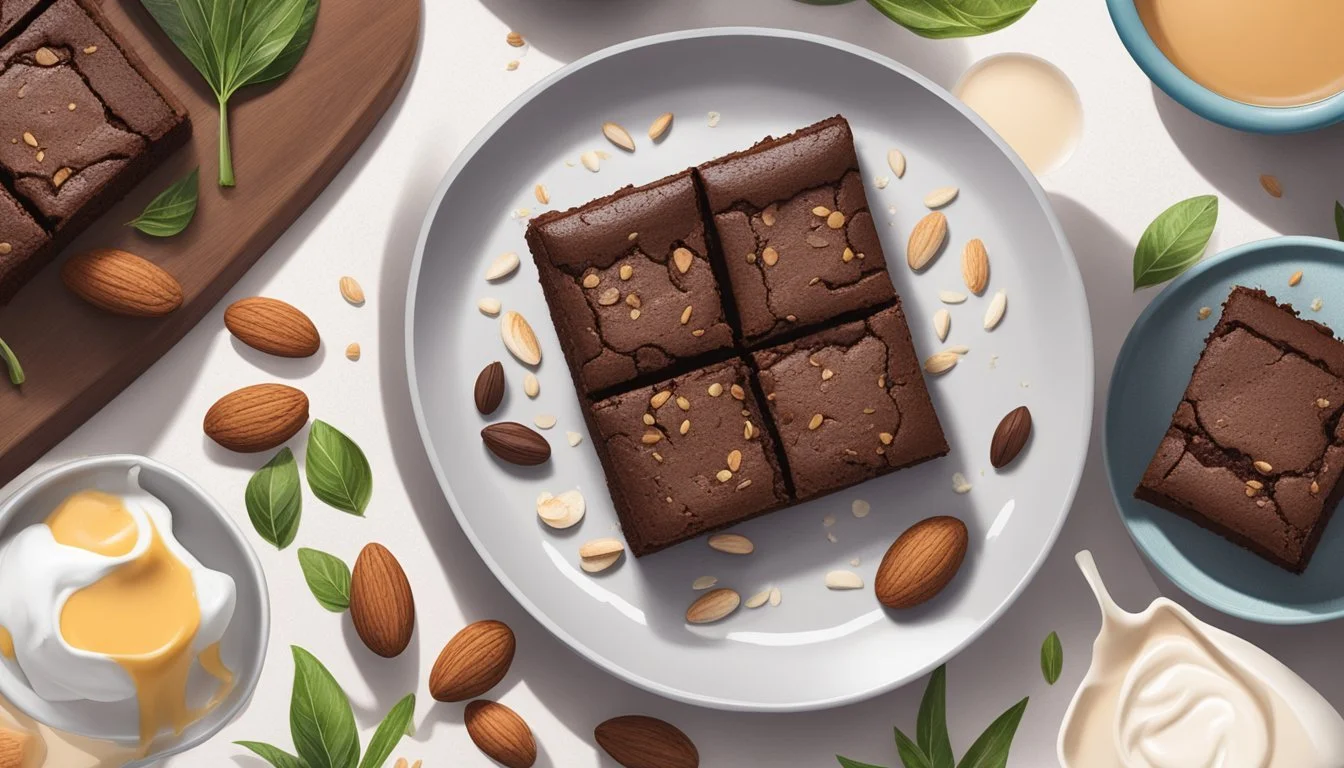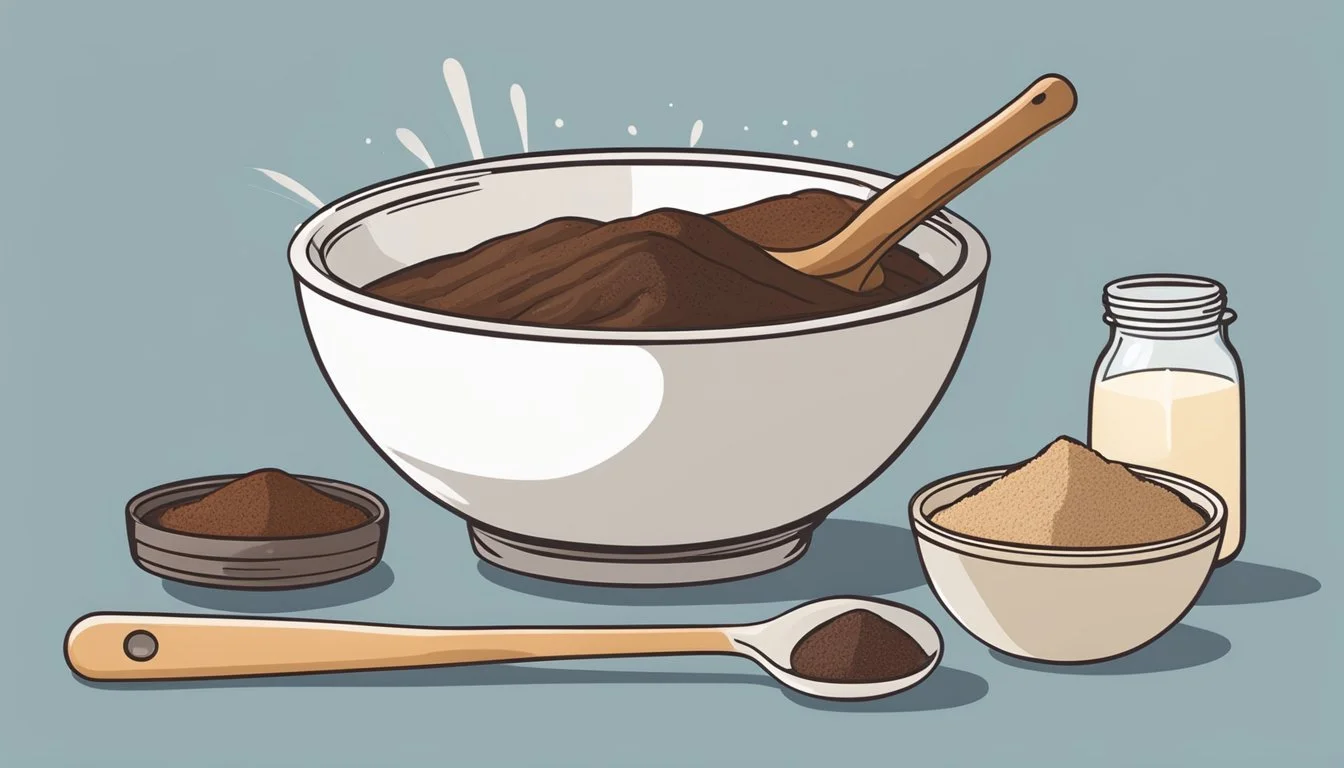Are Brownies Vegan?
Unveiling the Truth About This Classic Dessert
Traditional brownies are a classic baked treat known for their dense, rich, and chocolatey goodness. They typically contain ingredients such as butter, eggs, and chocolate (What wine goes well with chocolate?), which are not vegan-friendly. However, the versatility of the brownie has allowed for an array of adaptations to suit different dietary preferences and restrictions. This leads to the commonly asked question among plant-based enthusiasts: can brownies be vegan?
Vegan brownies are indeed a reality, crafted to cater to those who abstain from all animal products. The secret to veganizing brownies lies in substituting non-vegan ingredients with plant-based alternatives. Common dairy substitutes include coconut oil, vegan butter, and non-dairy milk, while eggs can be replaced with flax eggs, banana, or apple sauce. Vegan bakers have successfully created recipes that replicate the fudgy, moist texture of brownies without the use of traditional animal ingredients.
The rise of vegan baking has not only made it possible for vegans to enjoy brownies but has also introduced new flavors and textures to the world of brownies. Exploring the variety of vegan brownie recipes reveals that plant-based baking can yield results as delightful as the originals, if not more so. This proves that the essence of a brownie does not solely rely on its non-vegan components, but rather on the technique and creativity of the baker.
Understanding Veganism
When transitioning to a vegan lifestyle, identifying ingredients that align with vegan standards is crucial. The absence of animal-derived components is the cornerstone of veganism, especially in culinary contexts.
Defining Vegan Ingredients
Vegan ingredients are those that do not come from animals or contain any animal-derived substances. In the context of brownies or desserts, vegan alternatives play a vital role. They can include:
Non-dairy milk: Soy, almond, oat, and coconut milks are common plant-based alternatives to cow's milk.
Non-dairy butter: Made from a blend of oils and fats that do not originate from dairy.
Egg substitutes: Options like flaxseed or chia seeds mixed with water, banana, or commercially available vegan egg replacers provide binding properties.
A list detailing vegan alternatives:
Non-Vegan Ingredient Vegan Alternative Milk Soy, almond, oat, coconut milk Butter Plant-based oils and fats Eggs Flax or chia "eggs", banana
Common Non-Vegan Ingredients in Desserts
Non-vegan ingredients frequently found in desserts include:
Dairy products: Items like milk, butter, and cream are staples in traditional baking.
Eggs: Act as binders and leavening agents to provide structure and texture.
Their common presence in dessert recipes can pose a challenge for vegans, but a thorough understanding of alternatives ensures vegan desserts, such as brownies, can still be enjoyed.
Vegan Brownie Ingredients
Creating vegan brownies requires substituting traditional animal-based ingredients with plant-based alternatives. The specific ingredients are crucial for achieving the taste and texture similar to traditional brownies without the use of any animal products.
Vegan Chocolate Options
Vegan brownies often use cocoa powder or vegan chocolate chips as their chocolate base. True vegan chocolate should not contain any dairy products. When selecting chocolate chips, one should look for brands that specify vegan on the label to ensure they do not contain milk derivatives.
Cocoa Powder: Pure, unsweetened cocoa powder is inherently vegan and provides a rich chocolate flavor.
Chocolate Chips: Look for dairy-free chocolate chips or bars that can be chopped into small pieces.
Vegan Sweeteners
Vegan sweeteners can come in many forms, with coconut sugar being a popular choice due to its lower glycemic index.
Coconut Sugar: A natural sugar made from coconut palm sap, which can replace traditional white sugar.
Maple Syrup: Another natural sweetener that brings moisture as well as sweetness to brownies.
Agave Nectar: A syrup that is often used as a sweetener for its smooth texture.
Egg Substitutes in Baking
Eggs are commonly used in baking for their binding properties, but in vegan baking, alternatives like flax eggs are used.
Flax Eggs: A mixture of ground flax seeds and water, which gels up and acts as a binder.
Applesauce: A fruit puree that can also serve as a binding agent and adds moisture.
Choosing Vegan Fats
In traditional baking, butter provides flavor and a tender crumb, but vegan brownie recipes might use vegan butter or oils as a substitute.
Vegan Butter: Non-dairy butter often made from a blend of oils, provides richness similar to dairy butter.
Oil: Options like coconut oil or vegetable oil can be used to add moisture and help combine ingredients.
Almond Milk: Sometimes added to adjust the consistency of the batter, should be unsweetened to control the sugar content.
Careful selection of vegan ingredients ensures brownies are deliciously moist and fudgy without using animal products.
Vegan Brownie Variations
When it comes to vegan brownies, bakers can explore a myriad of variations that cater to different texture preferences and dietary needs. These adaptations can range from the type of flour used to small ingredient adjustments that alter the brownies' texture.
Fudgy vs. Cake-Like Vegan Brownies
Fudgy Brownies: For fudgy vegan brownies, one can ensure a dense and gooey texture by using ingredients that contribute to moisture, such as applesauce or vegan yogurt. Keeping the ratio of flour to fat lower also aids in achieving a chewy and chocolatey result. Substituting a portion of all-purpose flour for oat or almond flour can also enhance the fudginess.
Cake-Like Brownies: Those who prefer a lighter, cake-like texture will opt for a higher flour-to-fat ratio. Using all-purpose flour or whole wheat pastry flour can help achieve a risen, fluffier outcome. Considering a slightly higher quantity of baking powder can also contribute to this airier structure.
Gluten-Free and Allergy-Friendly Options
Gluten-Free Options: For gluten-free vegan brownies, bakers typically utilize gluten-free all-purpose flour or a blend of rice flour and a binding agent, such as xanthan gum. Almond flour and oat flour are also popular alternatives, adding a nutty flavor and aiding in creating a tender crumb.
Allergy-Friendly Variations: Allergy-friendly brownies may substitute nut flours with sunflower seed flour or avoid certain allergens altogether by using specific plant-based milk and allergy-friendly chocolate. Soy, nut, and oat milks are common vegan options, with each contributing a unique consistency and flavor to the brownies. It's important to select chocolate chips that are not only vegan but also cater to relevant allergy requirements.
By mindful selection and combination of ingredients, one can craft delicious vegan brownies that cater to a vast array of preferences and dietary restrictions, without compromising on taste or texture.
Vegan Brownie Recipes
Vegan brownies offer a delightful alternative to traditional brownies, eliminating all animal products without compromising on taste. They typically incorporate simple ingredients like sugar, pure vanilla extract, and unsweetened cocoa powder. The recipes vary from classic versions that mirror the fudgy texture to innovative takes that utilize unconventional ingredients for added nutrition and flavor profiles.
Classic Vegan Brownie Recipe
A classic vegan brownie recipe often begins with the foundation of unsweetened cocoa powder and sugar to recreate the quintessential chocolatey sweetness. Pure vanilla extract incorporated into the batter infuses the brownies with a rich, aromatic depth. Key ingredients include:
Flaxseed meal as an egg substitute, often mixed with water to create a 'flax egg'
Almond flour for a gluten-free option, adding a subtle nutty flavor and dense texture
Unsweetened cocoa powder as the chocolate base, providing deep chocolate flavor without additional dairy
Sugar, which can be any plant-based variety like coconut sugar or cane sugar
Oil or vegan butter to maintain moisture
The batter is then spread into the baking dish and cooked at a moderate temperature (typically around 350 degrees Fahrenheit) until the brownies reach the desired consistency.
Innovative Vegan Brownie Recipes
Innovative vegan brownie recipes challenge the norm and incorporate unique ingredients:
Black bean brownies: Utilizing black beans as the base, these brownies are high in protein and fiber. They often require blending the beans to a smooth texture before mixing them into the batter.
Sweet potato brownies: This version includes mashed sweet potatoes to naturally sweeten the brownies and provide a moist texture. Sweet potatoes also contribute valuable nutrients and a denser structure.
Regardless of the recipe, innovative vegan brownies retain a commitment to flavor and vegan ethics, while also interjecting a creative twist that often results in healthful benefits. These recipes cater to those looking to expand their palate and incorporate more plant-based choices into their dessert repertoire.
Baking Techniques and Tips
When it comes to vegan brownies, the techniques applied in the mixing, baking, and storing processes are critical for achieving a moist texture and rich flavor that appeal to vegans and non-vegans alike.
Mixing and Baking for Optimal Texture
For vegan brownies to achieve the desired texture, one must pay careful attention to the mixing process. Avoid overmixing the batter, as it can develop gluten and result in a tougher brownie. Opt for a gentle folding method. Consider using baking powder for leavening to create a lift in the absence of traditional eggs. This will contribute to a lighter, more inviting texture.
When lining the baking dish, parchment paper is indispensable; it prevents sticking and allows for easy removal. Distribute the batter evenly in the pan and tap it gently on the counter to remove air bubbles. Baking at 350 degrees Fahrenheit usually offers a soft but fully set brownie; however, ovens vary, so adjust the baking time accordingly.
Testing for Doneness
To ensure brownies are perfectly baked, use the toothpick test. Insert a toothpick into the center; it should come out with a few moist crumbs attached, not coated in wet batter. If the toothpick is clean, the brownies may be overbaked. For thicker brownies, additional baking time may be required, whereas thinner brownies will take less time.
Storing and Freezing Brownies
To maintain brownies' moisture and freshness after baking, allow them to cool on a wire rack. Once cool, transfer the brownies to an airtight container to keep them from drying out. For long-term storage, wrap individual brownies in cling film, and then seal them in a freezer-safe container. These can be stored in the freezer for up to three months. To enjoy, one can simply thaw them at room temperature or briefly warm them in the microwave.
For immediate consumption, brownies can stay fresh when kept at room temperature for several days. To extend freshness, one might refrigerate the brownies in their container; this is especially useful in warmer climates.
Serving and Presentation
Serving vegan brownies is both an art and a practical consideration, involving thoughtful choices of accompaniments and decorative touches to enhance the dessert experience.
Accompaniments for Vegan Brownies
For a complete dessert experience, pairing vegan brownies with accompaniments that complement their rich flavor is crucial. A scoop of vegan ice cream, whether it's vanilla or a more adventurous flavor, provides a creamy contrast to the dense brownies. Coconut whipped cream is another excellent choice, offering a light and airy texture along with a subtle tropical hint. Those seeking a healthier option might opt for a fruit compote or fresh berries for a tart counterpoint to the sweetness.
For textural contrast and added taste, a range of nuts can be mixed in or sprinkled on top before serving. Both walnuts and hazelnuts are traditional favorites that offer a satisfying crunch and nuttiness.
Decorative Ideas
Presentation significantly impacts the enjoyment of any dessert, and vegan brownies are no exception. Creating a visually pleasing plate can be achieved with minimal effort. A simple dusting of powdered sugar can add an elegant touch, while a drizzle of vegan chocolate ganache will give a glossy, indulgent finish.
For those who enjoy a bit of extra flavor and decoration, a dollop of vegan frosting can be piped onto each brownie. Choosing a frosting flavor that complements the brownie, such as peppermint or raspberry, will elevate the dessert while adding vibrant color and taste. A few edible flowers or mint leaves may also be placed for a natural and striking garnish.
Nutritional Considerations
When exploring the nutritional profile of vegan brownies, one should pay close attention to their caloric content and the benefits specific to the plant-based ingredients within.
Caloric Content of Vegan Brownies
The caloric content of vegan brownies can vary depending on the ingredients used. A typical vegan brownie might substitute eggs and butter with ingredients like black beans or dates, which can affect the total calories. Black beans are a low-calorie ingredient that also add fiber and moisture to the brownies. On the other hand, dates provide natural sweetness while contributing to the moistness desired in a brownie's texture, but they are higher in calories due to their sugar content.
Pure cane sugar, commonly used in both traditional and vegan baking, contributes mostly empty calories without nutritional benefits.
Homemade vegan brownies offer the advantage of controlling the quantity and quality of the ingredients, influencing the total caloric count.
Health Benefits of Vegan Ingredients
Vegan brownies often incorporate a range of plant-based ingredients that provide various health benefits. For instance, using dates not only supplies natural sweetness but also provides dietary fiber and essential nutrients, contributing to the overall healthfulness of the brownie.
Black beans serve as a health-conscious addition, offering protein, fiber, and antioxidants without compromising the taste or texture.
The absence of eggs and dairy means lower cholesterol and saturated fat content, making them a heart-healthier option.
Many vegan brownie recipes replace flour with nuts or seeds, enhancing the nutrient profile with healthy fats and proteins.
Advanced Vegan Baking
In the realm of advanced vegan baking, one must understand the specific chemistry behind traditional ingredients and their plant-based alternatives. It's not merely about replacing animal products but mastering their unique properties to achieve comparable results. The science is precise, the substitutes are innovative, and the techniques are skillful.
Exploring Vegan Baking Chemistry
Advanced vegan baking emphasizes the importance of understanding the chemical reactions that occur during the baking process. Traditional baked goods rely on eggs and dairy to provide moisture, fat, and the backbone for structures to form. In vegan baking, substitutes like aquafaba—the liquid from canned chickpeas—mimic the emulsifying properties of eggs. Additionally, when baking soda, a common leavening agent, is present, it reacts with acidic ingredients such as apple cider vinegar, creating carbon dioxide which helps to raise and lighten the batter.
Vegan Baking Substitutes
The table below outlines key vegan substitutes for traditional baking ingredients, assisting in the creation of vegan-friendly versions of classic treats like brownies:
Traditional Ingredient Vegan Substitute Function in Baking Eggs Aquafaba Binding, leavening, and moisture Butter Plant-based oils Fat source for tenderness and flavor Milk Almond, soy, coconut milk Liquid for hydration and chemical reactions Chocolate Chips Vegan Chocolate Chips Flavor without dairy content
Using vegan chocolate chips ensures that the end product is free from dairy. Vanilla extract is typically vegan and is crucial for adding depth of flavor. Dutch cocoa powder and salt, both inherently vegan, contribute to the rich flavor profile of darker baked goods.
Creative Vegan Baking Techniques
The art of vegan baking calls for creative techniques. A popular egg substitute, flax or chia seeds mixed with water creates a gel-like substance, providing the binding property necessary for structure. For lightness and rise, a combination of baking soda and an acid like vinegar or lemon juice can be employed. The strategic layering of flavors, such as the depth from vanilla and the richness of salt-accentuated chocolate, is key. When it comes to folding in chocolate chips, the baker should ensure they opt for high-quality vegan chocolate chips to maintain a rich, indulgent character in the final product.
Beyond Brownies
When exploring the realm of vegan sweets, chocolate remains a consistent favorite. The versatility of chocolate allows for an array of delectable treats beyond the traditional brownie, including other baked goods and ways to incorporate brownie pieces into larger desserts.
Other Vegan Chocolate Treats
Vegan chocolate recipes are diverse, satisfying various taste preferences and dietary requirements. These recipes substitute animal products with plant-based ingredients without compromising flavor or texture.
Chocolate Chip Cookies: A classic favorite, these can be made vegan by using dairy-free chocolate chips and substituting eggs with flaxseeds or applesauce for binding.
Chocolate Cake: A rich, moist cake that utilizes almond milk and vegan butter to achieve a traditional taste and texture.
One can also indulge in vegan fudges, mousses, and even chocolate-infused coffee beverages, all tailored to be dairy-free and egg-free. Brewed coffee can serve as an ingredient to enhance the depth of chocolate flavor in these treats.
Incorporating Brownies into Larger Desserts
Leftover brownies need not go to waste; they make excellent ingredients for larger, more elaborate desserts.
Brownie Trifle: Layer crumbled brownie pieces with vegan whipped cream, fruit, and dairy-free pudding.
Brownie Ice Cream Cake: Combine brownie chunks with vegan ice cream and freeze, creating a fusion of textures and flavors that are both refreshing and indulgent.
Utilizing leftover brownies in this manner not only prevents food waste but also provides an opportunity to be creative in the kitchen.









